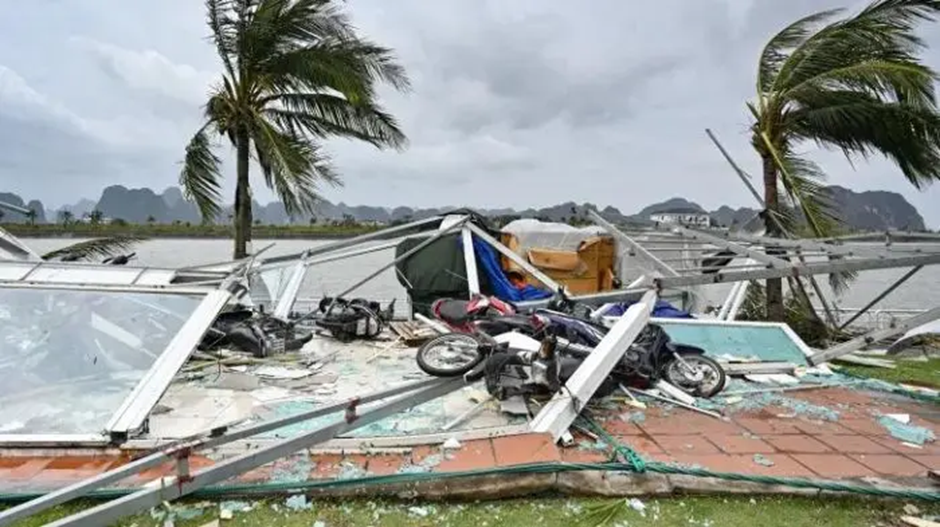- Courses
- GS Full Course 1 Year
- GS Full Course 2 Year
- GS Full Course 3 Year
- GS Full Course Till Selection
- Answer Alpha: Mains 2025 Mentorship
- MEP (Mains Enrichment Programme) Data, Facts
- Essay Target – 150+ Marks
- Online Program
- GS Recorded Course
- Polity
- Geography
- Economy
- Ancient, Medieval and Art & Culture AMAC
- Modern India, Post Independence & World History
- Environment
- Governance
- Science & Technology
- International Relations and Internal Security
- Disaster Management
- Ethics
- NCERT Current Affairs
- Indian Society and Social Issue
- NCERT- Science and Technology
- NCERT - Geography
- NCERT - Ancient History
- NCERT- World History
- NCERT Modern History
- CSAT
- 5 LAYERED ARJUNA Mentorship
- Public Administration Optional
- ABOUT US
- OUR TOPPERS
- TEST SERIES
- FREE STUDY MATERIAL
- VIDEOS
- CONTACT US
Typhoon Yagi Becomes Asia's Most Powerful Storm
Typhoon Yagi Becomes Asia's Most Powerful Storm
19-09-2024

Typhoon Yagi has emerged as the strongest tropical cyclone in Asia this year, causing widespread devastation across multiple countries, particularly Vietnam, where the death toll has reached around 233.
- Overall, fatalities across affected nations have surpassed 300, with many people still reported missing.
Formation of Tropical Cyclones:
- Process: Tropical cyclones form over warm ocean waters near the equator. Warm, moist air rises from the ocean surface, creating a low-pressure area. Surrounding high-pressure air rushes in, warming and rising as well.
- Development: As the warm air rises and cools, it condenses into clouds and thunderstorms, gaining strength from ocean heat and evaporated water.
- Classification: Cyclones are categorized based on sustained wind speeds:
- Tropical Depression: Less than 39 mph (63 km/h)
- Tropical Storm: 39 to 73 mph (63 to 119 km/h)
- Hurricane/Typhoon/Cyclone: 119 km/h and above
- Categories range from 1 (119-153 km/h) to 5 (252 km/h or higher).
Typhoon Yagi's Journey:
- Formation: Yagi began as a tropical storm in the western Philippine Sea on September 1, 2024, making landfall in the Philippines on September 2.
- Intensification: It weakened initially but strengthened again due to warm waters in the South China Sea, reaching Category 5 status with peak winds of 260 km/h by September 5.
- Impact: Yagi made landfall in China's Hainan province and later in northern Vietnam, resulting in significant damage and flooding.
Climate Change and Tropical Cyclones:
- Impact Uncertainty: Scientists are divided on the precise effects of climate change on tropical cyclones due to multiple influencing factors.
- Growing Consensus: There is agreement that rising global temperatures contribute to more intense storms. A study in Climate and Atmospheric Science noted that cyclones in Southeast Asia are forming closer to shore, intensifying rapidly, and lingering longer over land.
- Mechanisms: Increased ocean temperatures lead to:
- Higher evaporation rates and heat transfer to the atmosphere.
- More water vapor and heat absorbed by storms, resulting in stronger winds and heavier rainfall.
Conclusion:
Typhoon Yagi underscores the growing threat posed by tropical cyclones in the context of climate change. With rising global temperatures and changing ocean conditions, such storms are expected to become increasingly severe, necessitating improved preparedness and response strategies across affected regions.
Must Check: Best IAS Coaching In Delhi
UPSC Prelims Result 2024 Out: Expected Cut Off & Other Details, UPSC Prelims 2024 Answer with Explanation, Daily Prelims Quiz, Daily Current Affairs, MONTHLY CURRENT AFFAIRS TOTAL (CAT) MAGAZINE, Best IAS Coaching Institute in Karol Bagh, Best IAS Coaching Institute in Delhi, Daily Mains Question Answer Practice, ENSURE IAS UPSC Toppers, UPSC Toppers Marksheet, Previous Year Interview Questions, UPSC Syllabus




